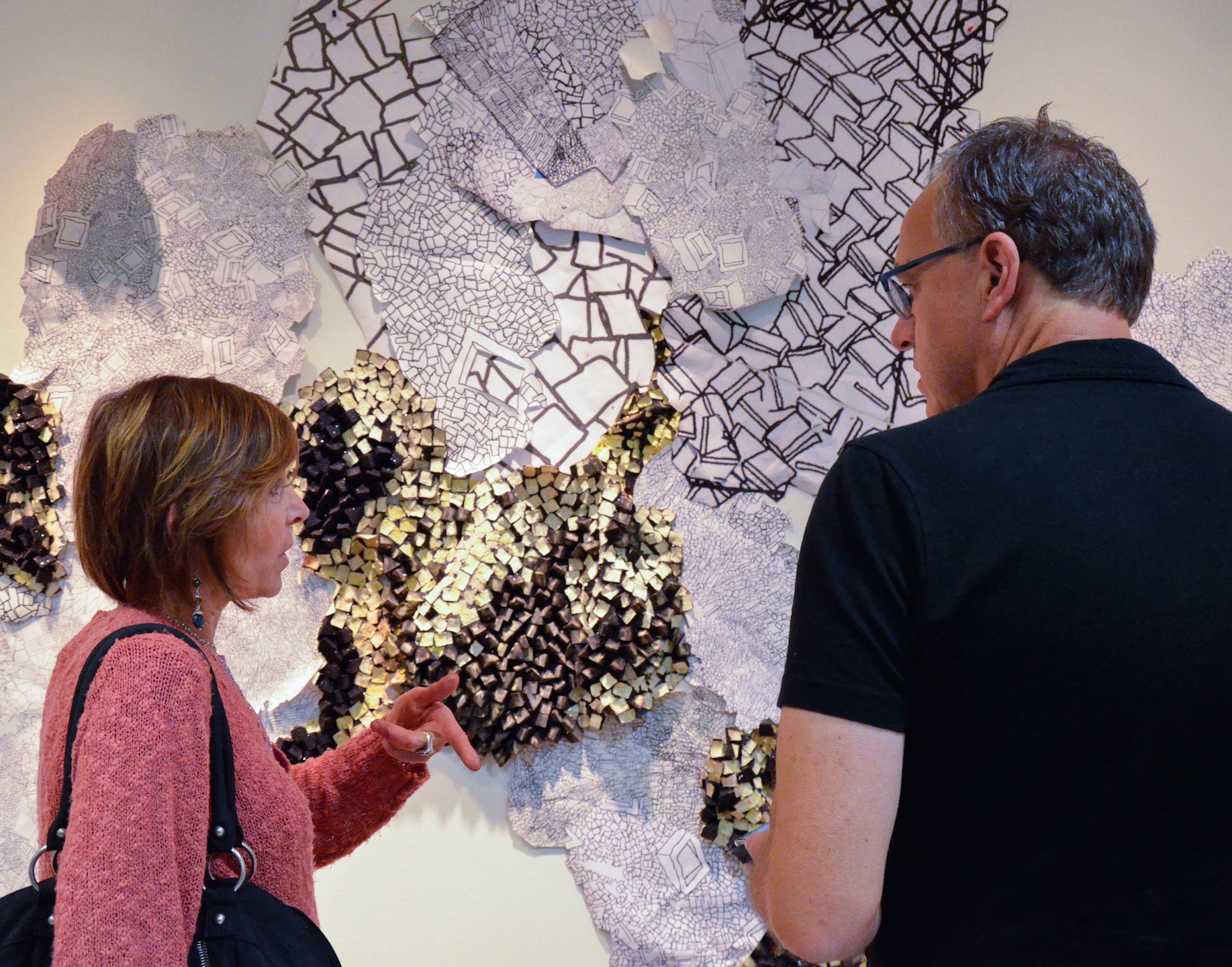 Margery Amdur’s dual Under Cover exhibits at Augsburg University are a rare glimpse into the process of art making. The Gage Gallery hosts Amdur’s completed installation, and the Christensen Gallery exhibits a collection of experiments and working processes that she uses in her practice and in this project in particular.
Margery Amdur’s dual Under Cover exhibits at Augsburg University are a rare glimpse into the process of art making. The Gage Gallery hosts Amdur’s completed installation, and the Christensen Gallery exhibits a collection of experiments and working processes that she uses in her practice and in this project in particular.
It is an understatement to say that Amdur has been generous in allowing the viewer into her artistic process. This kind of process work most often occurs well away from public eyes, and most artists are happy with that arrangement. There is safety in presenting only a finished product. Such isolation conceals failures, false starts, and decision-making processes and reinforces notions of “talent” that the artist might want to preserve. The glass walled Gage Gallery is also a very public space, leaving nowhere to hide. By constructing the work on site, Amdur lived out the process of art making in public in real time, a remarkable gift of honesty and vulnerability for the Augsburg community.
The Under Cover exhibits are two of several shows in the Twin Cities this fall related to a body of research into the methods and activities that successful artists use to sustain long-term artistic viability. This research occurred over a three-year period and was principally based on interviews with successful mid-career artists, including Amdur. The goal of the research was not to determine a formulaic set of criteria, but to aggregate the collected wisdom of this group into a constellation of activities that most artists do most of the time that keep them moving forward and productive in a sustainable practice. The resultant book, Creative Practices For Visual Artists: Time, Space, Process (Routledge Press 2018) explored these themes.
In both of Amdur’s exhibits we see examples of key ideas that emerged from the author’s interview research. One such theme is the tendency of artists to reinterpret visual ideas developed in one media into new media and materials. This is evident throughout the installation, as color groups, rhythmic patterning and structural imagery are translated back and forth between multiple media and dimensions. The elements in the installation are decidedly akin, with tremendous richness in this complexity as the visual ideas compliment, contradict, and interrelate. This is not simply a baroque layering of repetitive ornamentation, but a deep engagement with structural connections between many forms of natural and anthropocentric systems.
Amdur’s work in the Christensen Gallery, seemingly teleports much of her Philadelphia based studio into the gallery space. The exhibit includes a range of raw materials, multiple experiments, nearly finished works, and project stations on which viewers are invited to work on her constructions. The gallery demonstrates another key principle of art making: that successful artists are much more focused on maintaining a process out of which artwork periodically emerges than they are focused on making singular works. There is a sense of relentless experimentation visible here, and a radical hospitality to exploring potential new ideas, some of which clearly found their way into the finished installation. Used painting gloves, cosmetic sponges, and drinking straws fused with gel medium are all given serious consideration as potential participants in her works.
It is not that Amdur’s process is so open that any material/process/object can be indiscriminately dropped into it, an approach that would suggest a lack of intent and vision, but rather that her practice allows for many materials/ideas to become integrated into her visual lexicon through her joyful (and quite intense) manipulation and fabrication methods. This radical hospitality toward new input is not the end, but the beginning of the process by which new ideas and content are introduced into her works, a methodology that is constantly responsive to new opportunities and directions.
Less evident in the finished installation was an experience that occurred during its construction that illustrates a final key idea about artistic practice. After developing components of the project in her studio for months, then working with them for several days in the gallery, Amdur stated “I looked at the piece, and it just was not working, and I realized that I just needed to do something different than what I had planned.” It was a moment that seasoned artists know well, as they face the limitations in their ability to predetermine where the art is going and how it might be successful. To a large degree, artists are finding their best work within their process, often in ways they don’t expect. These are moments that Amdur says “mirrors who we are and reflects the best part of ourselves back to us.” It is a paradoxical way of working in which the results of dedicated experimentation, labor and research are necessary, but not enough to move beyond our own limitations. We often need to break our preconceptions as well.
Fittingly, Amdur states that paradox is a key idea in Under Cover. We can see it in the way the installation simultaneously engages many forms of dualities and tensions that stand in balance and counterbalance. The work does not allow an easy resolution between them but permits us to experience their dynamic relationship in a way that is more honest, raw, and unfiltered.
-Kenneth Steinbach
More information about Creative Practices For Visual Artists: Time, Space, Process and supporting research can be found at kennethsteinbach.com.
